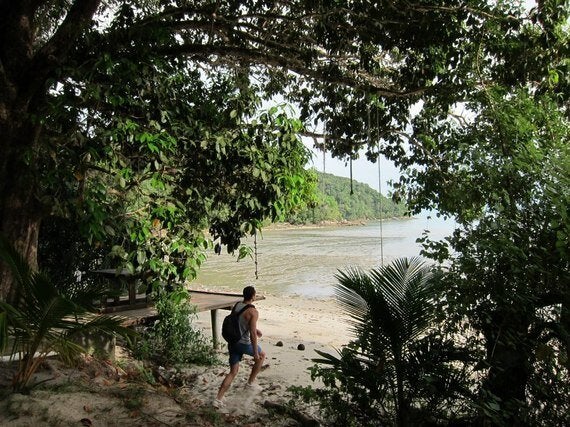
Tom runs through a protected rainforest in Penang, Malaysia (Image: Blogger's Own)
Robert and I ran. We had thrown a grenade into an empty, desolate car park and were scared of being caught. The grenade wasn't going to explode, we knew that, but we still ran.
Thump. Muffled and soft, it was as if someone punched a pillow. Twenty paces away we stopped. We looked at each other and we grinned.
The grenade was a Christmas tree seed bomb. Seeds of a Norwegian Christmas tree packed into a green clay ball that opens on impact and is pre-germinated with compacted nutrients to help growth. We bought it from The Seed Bomb Factory.
Weeks prior, Robert and I had met at a Trees for Cities volunteering event where you plant a dozen trees or more in a day around London. In 2010 I made the principled decision to pick trees as the good thing I was going to champion for my life, and have since been a big supporter of Trees for the Future (plant a tree for $0.20) and other related organisations. Yet at the volunteering event Robert and I shared a grumble.
"We're going to have to do this for quite a while if we want to make a difference." Robert said.
26 billion trees are cut down every year and only 15 billion are replanted. Just like our economy, we're in a tree deficit. If we want to make a difference we're going to have to plant faster. Together, Robert and I managed 20 trees in the day (large saplings) - one street in East London.
The Seed Bomb Factory's Christmas trees were the next step in our quest for faster tree planting. We bought a few and made our own following this guide, then ran around London throwing them over walls and into hard to reach areas. Returning a year later it was a delight to see many of them had caught hold and were growing into beautiful (carbon-storing, oxygen breathing, property-value appreciating) trees. Yet even if we had done it everyday all day we would have barely made a difference on a global level.
If we want our world to be green again, for forests to come back and thrive, then we're going to have to have to put in a massive effort. And until recently I was worried this would never be possible. Now there is hope.
Lauren Fletcher is the CEO of BioCarbon Engineering, a British company that seeks to plant one billion trees per year. How? Drones. Load some drones with seed bombs and fly them out over deforested areas and let them drop. Pop, pop, pop.
The company estimates that if I ran around with a sack full of seed bombs I could manually plant 3,000 per day. The drones could do 36,000. Now imagine an army of them. Semi-autonomous robots scanning the land, collecting data on soil types and terrain, then mapping out the best opportunities for tree planting and correct varieties. One billion trees per year (which is still 11 billion short, but it's progress).
Can this seed bombing technique really work? Yes. It's actually been around since the 1930s. War planes were re-kitted to drop seed bombs on Mount Honolulu. Lockheed Martin, the US manufacturer, redeveloped the C-130 Transport Aircraft which used to offload thousands of explosive mines to be able to drop 900,000 seed bombs in one go. While the success rate of a seed bomb becoming a tree is less than it is from physically planting it in the ground, it's a fraction of the cost so you can fire more.
Finally there's an awesome solution to a massive problem. To make sure it happens we have to rally behind it, put pressure on relevant Government departments to give a lending hand, and spread the word. In the meantime, learn how to make your own seed bomb here and throw it somewhere that needs some green love.
Read more from Tom on his blog, Screams
